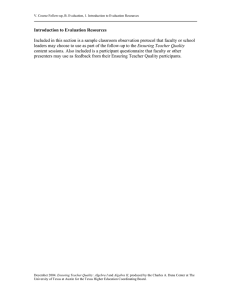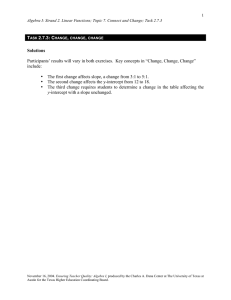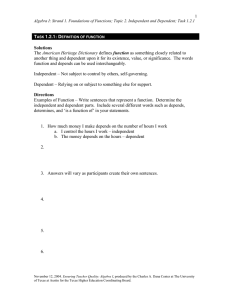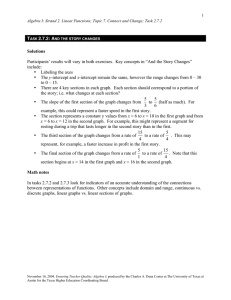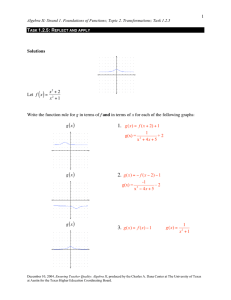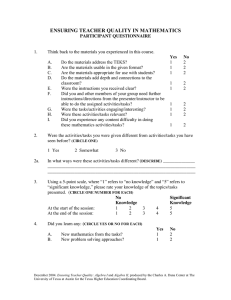1 • What makes a function linear?
advertisement
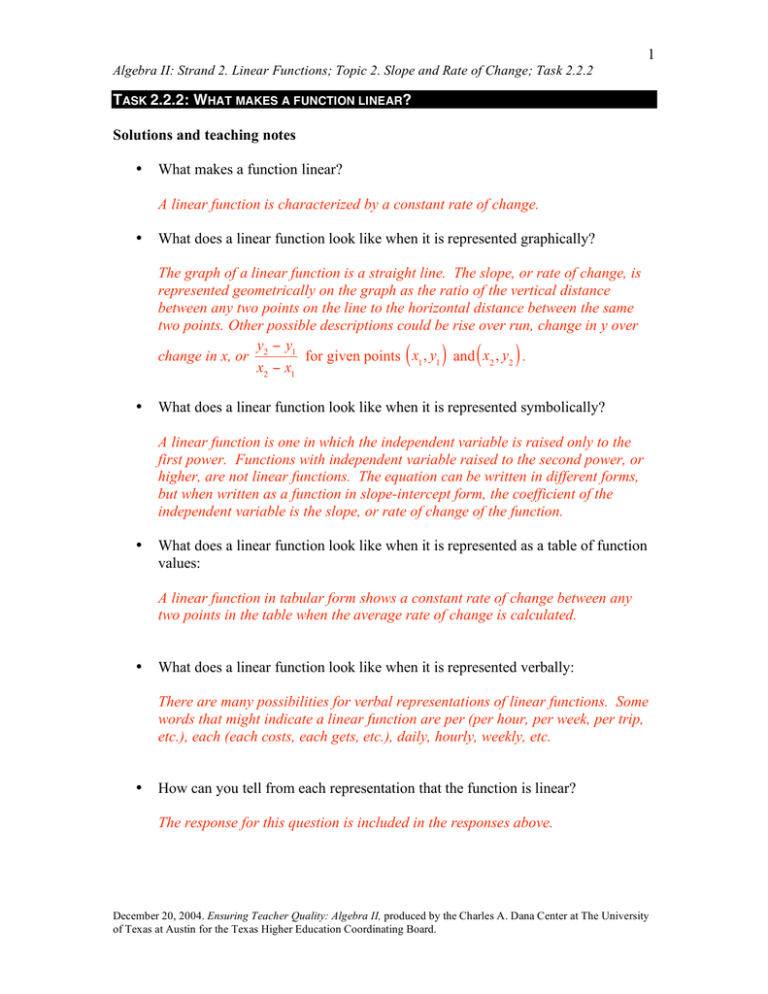
1 Algebra II: Strand 2. Linear Functions; Topic 2. Slope and Rate of Change; Task 2.2.2 TASK 2.2.2: WHAT MAKES A FUNCTION LINEAR? Solutions and teaching notes • What makes a function linear? A linear function is characterized by a constant rate of change. • What does a linear function look like when it is represented graphically? The graph of a linear function is a straight line. The slope, or rate of change, is represented geometrically on the graph as the ratio of the vertical distance between any two points on the line to the horizontal distance between the same two points. Other possible descriptions could be rise over run, change in y over y ! y1 change in x, or 2 for given points x1 , y1 and x2 , y2 . x2 ! x1 ( • ) ( ) What does a linear function look like when it is represented symbolically? A linear function is one in which the independent variable is raised only to the first power. Functions with independent variable raised to the second power, or higher, are not linear functions. The equation can be written in different forms, but when written as a function in slope-intercept form, the coefficient of the independent variable is the slope, or rate of change of the function. • What does a linear function look like when it is represented as a table of function values: A linear function in tabular form shows a constant rate of change between any two points in the table when the average rate of change is calculated. • What does a linear function look like when it is represented verbally: There are many possibilities for verbal representations of linear functions. Some words that might indicate a linear function are per (per hour, per week, per trip, etc.), each (each costs, each gets, etc.), daily, hourly, weekly, etc. • How can you tell from each representation that the function is linear? The response for this question is included in the responses above. December 20, 2004. Ensuring Teacher Quality: Algebra II, produced by the Charles A. Dana Center at The University of Texas at Austin for the Texas Higher Education Coordinating Board. 2 Algebra II: Strand 2. Linear Functions; Topic 2. Slope and Rate of Change; Task 2.2.2 Math notes Developing a repertoire of multiple representations and metaphors for linear functions is crucial in building rich understanding of linear functions. The unique characteristic that a linear function has a constant average rate of change over any interval is fundamental in building these multiple representations. Teaching notes The instructor may consider assigning Task 2.2.2 for homework and having participants create their charts based upon their work in groups at the following session. December 20, 2004. Ensuring Teacher Quality: Algebra II, produced by the Charles A. Dana Center at The University of Texas at Austin for the Texas Higher Education Coordinating Board. 3 Algebra II: Strand 2. Linear Functions; Topic 2. Slope and Rate of Change; Task 2.2.2 TASK 2.2.2: WHAT MAKES A FUNCTION LINEAR? TASK 2.2.2: WHAT MAKES A FUNCTION LINEAR? Work in pairs or small groups as directed by your instructor. Discuss the following questions with your partner(s): • • • • • • What makes a function linear? What does a linear function look like when it is represented graphically? What does a linear function look like when it is represented symbolically? What does a linear function look like when it is represented as a table of function values? What does a linear function look like when it is represented verbally? How can you tell from each representation that the function is linear? Make a poster answering the question, “What makes a function linear?” Include verbal, graphic, tabular, and symbolic representations of a linear function and tell how you can determine from each different representation that the function is linear. December 20, 2004. Ensuring Teacher Quality: Algebra II, produced by the Charles A. Dana Center at The University of Texas at Austin for the Texas Higher Education Coordinating Board.
